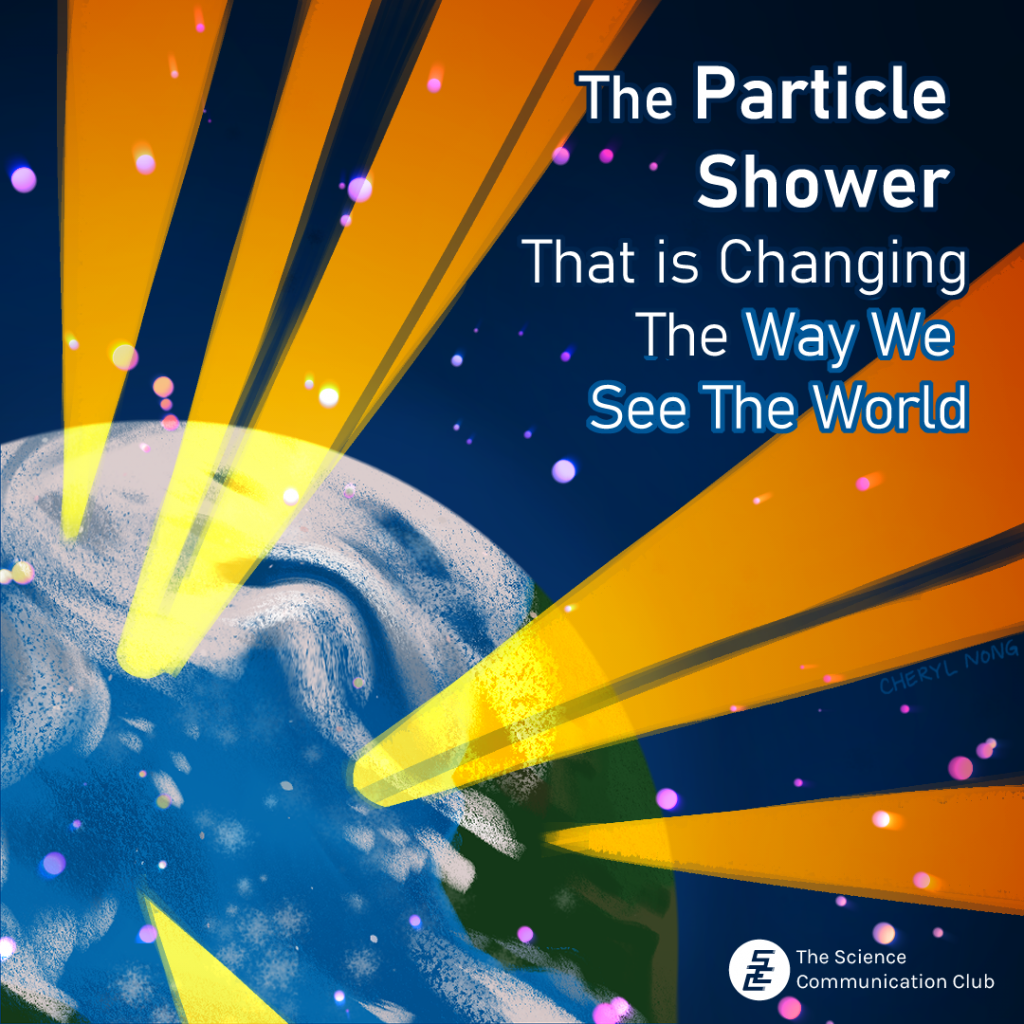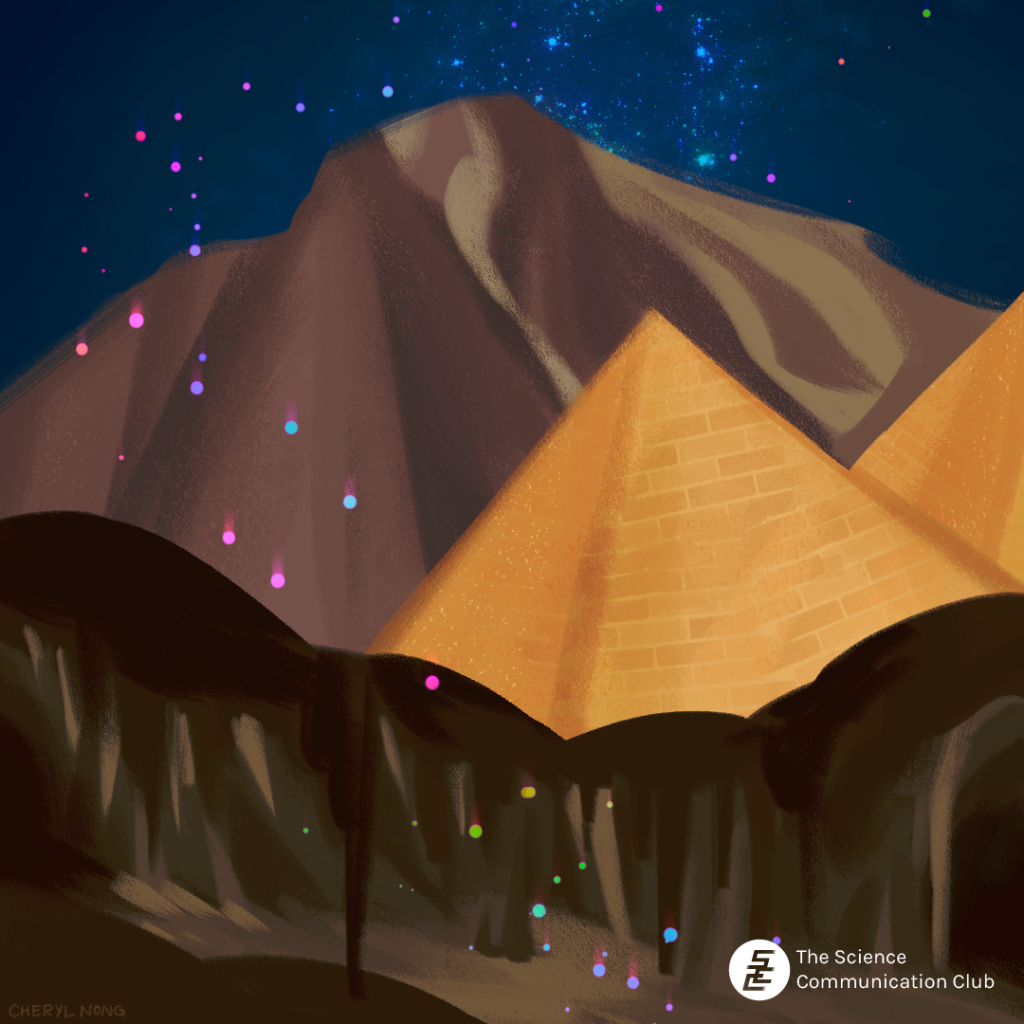
Written by Anne-Marie Bulboaca
Illustrated by Cheryl Nong
Life on Earth exists under a constant particle shower. Tiny invisible particles form in the atmosphere and fall towards the Earth’s surface, passing through our bodies and everything around us on their way. From the Great Pyramids of Giza to Mount Vesuvius, one such particle, the muon, is being used by particle physicists to make new discoveries about the physical structures that surround us on Earth.
To many, the muon may seem like a completely foreign concept. But believe it or not, plenty of muons have passed through your body in the time it took you to read this sentence. One muon passes through an area the size of your palm every second.1
So, what exactly is a muon? The muon is one of the fundamental subatomic particles, meaning it is a component of an atom and is among the smallest units that make up the world around us; it cannot be further divided into smaller parts.2 Understanding the characteristics of this particle is crucial to understanding its applications; its properties make it the ideal particle for structural studies. The muon is a negatively charged particle with the same amount of charge as an electron.2 However, it has a mass of approximately 207 electrons, meaning it is able to effectively pass through more materials.2 Muons are created when atmospheric particles collide with cosmic rays (protons and atomic nuclei that move through the atmosphere at very high energies and rapid speeds).2 The fundamental forces of gravity (the attractive force exerted by objects of large mass), weak force (which governs particle decay), and electromagnetism (the force exerted by charged particles) then cause the muon particles to fall towards the Earth and interact with other structures.3 The muon exists for up to 2.2 milliseconds before it decays into an electron and two neutrinos.2 This might not seem long, but the particle travels at a speed just below the speed of light, covering extensive distances before decaying.2 If we think of an electron as a bullet being shot through a wooden plank, a muon would be a cannonball.1 A typical muon will penetrate roughly a mile below the Earth’s surface before decaying.2

These unique characteristics make this particle ideal for applications in imaging. Muon Scattering Tomography (MST) is a technique that analyzes the paths of muons to map structures on Earth that are hidden to the human eye, such as underground cave networks.4 MST is based on the principle of Coulomb scattering; because muons are negatively charged, they are repelled by the negatively charged electrons in the materials they pass through, a phenomenon described by Coulomb’s force.4 Therefore, a higher density material will have a stronger repulsive effect on a passing muon.4 By collecting data on deflection angles, researchers can gain information about the structure and density of an object.4 This has been especially useful in studying hidden structures, as they are obstructed to the human eye, but can be reached by muon particles. MST essentially uses muons to perform a massive x-ray scan.1
Some of the most interesting applications of this process have included the ScanPyramids project, which used muons to detect a new void in the Great Pyramid of Giza in 20175. This was the first new structure to be detected in one of the Pyramids of Giza since the 19th century.5 MST is also being applied to the study of volcanoes, particularly active Mount Vesuvius.5 By mapping the internal structures of the volcano, researchers are able to detect structures that might have cataclysmic effects in the event of an eruption, such as ash clouds and pyroclastic flows (rapid, extremely hot mixtures of rock fragments and gases that incinerate everything in their path).5 This application has the potential to save countless lives, as anyone at risk could be alerted of the danger in advance and evacuated. The power of this tiny particle in developing our understanding of the world around us is truly fascinating.
Sources
- Muons spill secrets about Earth’s hidden structures. 2022. Science News. [accessed Feb 11 2023]. https://www.sciencenews.org/article/muon-subatomic-particle-volcano-pyramid-physics.
- DOE Explains…Muons. 2022. U.S. Department of Energy. [accessed Feb 11 2023]. https://www.energy.gov/science/doe-explainsmuons#:~:text=The%20muon%20is%20one%20of.
- The Four Fundamental Forces of Nature. 2019. Space.com. [accessed Feb 11 2023]. https://www.space.com/four-fundamental-forces.html.
- Miyadera H, Morris CL. 2022. Muon scattering tomography: review. Applied Optics. 61(6):C154. [accessed Feb 11 2023]. doi:https://doi.org/10.1364/ao.445806.
- How scientists are using cosmic radiation to peek inside the pyramids. 2021. BBC Science Focus Magazine. [accessed Feb 11 2023]. https://www.sciencefocus.com/future- technology/howscientists-are-using-cosmic-radiation-to-peek-inside-the-pyramids/.